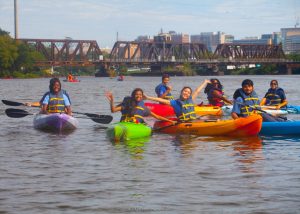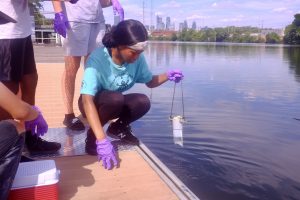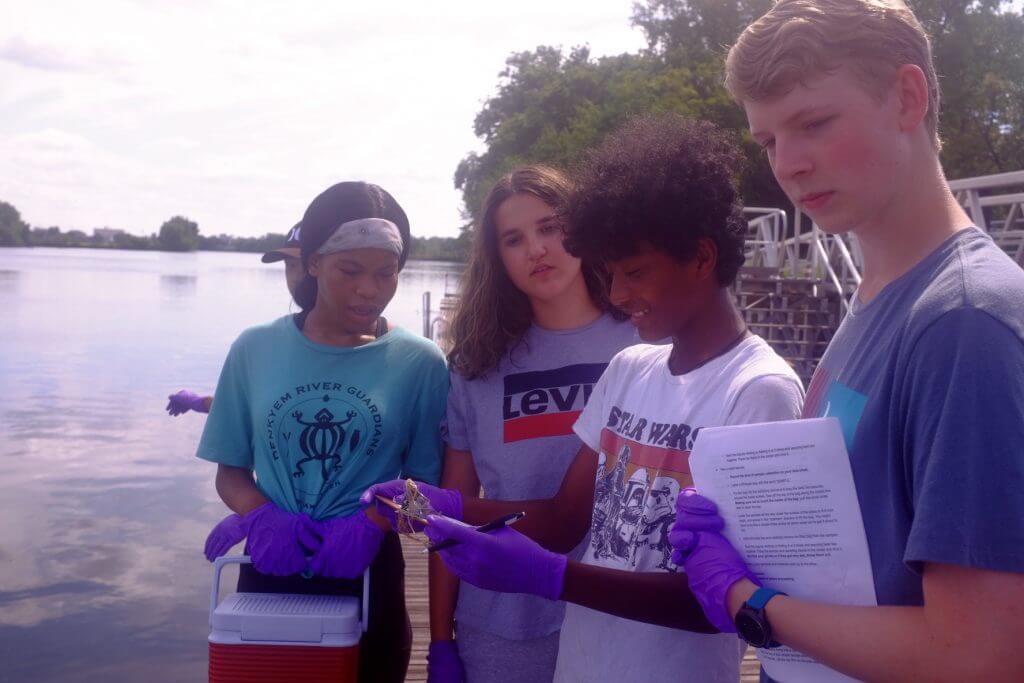Featured Communities – Bartram’s Garden, Philadelphia
This piece was written by Chloe Wang, River Programs Manager at Bartram’s Garden.

Photo courtesy Bartram’s Garden.
The Schuylkill River, one of the Delaware River Basin’s largest tributaries, spans from mountainous headwaters in eastern Pennsylvania to its confluence south in Philadelphia. The Schuylkill provides drinking water and recreation opportunities for surrounding communities, and vital habitat for fish and wildlife. Bartram’s Garden (The Garden) is an historic botanical garden and public park located in Southwest Philadelphia, along the lower, tidal portion of the Schuylkill River. With the only public dock on the Lower Schuylkill, Bartram’s Garden Community Boathouse offers free kayaking, rowing, and fishing programs for thousands of visitors each year. The goal of the Boathouse is “to create a welcoming, accessible, affirming, fun and safe experience for guests of all abilities and from all backgrounds,” with a focus on expanding river access for Southwest Philadelphia residents. A crew of 75+ volunteers, as well as paid, local high school interns – the Denkyem River Guardians – help to operate public Boathouse programs. The Guardians learn about, and build relationships with, the Schuylkill through lenses of science, history, arts and culture.
The Problem
There are 40 Combined Sewer Outfalls (CSOs) on the tidal Schuylkill River, several of which are located in close proximity to the Garden’s boat docks, where the community boating program launches, and locals take advantage of the prime fishing spot. Though the river offers respite and recreation in an otherwise bustling city, the immense presence of CSOs often creates unsafe conditions for water contact. As a result, Bartram’s Garden is forced to cancel many boating opportunities. However, it has been challenging to determine a well-informed cancellation policy, due to a lack of historical data documenting relationships between weather, combined sewer overflows, and water quality.
Despite the frequent occurrence of on-water recreation, this section of the Schuylkill River, as well as the mainstem Delaware River through Philadelphia, is not protected for primary contact recreation under the Clean Water Act. Barriers to upgrading the recreational use designation of this section of the river have been extensive – including a lack of data and understanding of the pollution sources and impairment levels, lack of attention by agencies, unclear division of responsibility between agencies with overlapping jurisdiction, conflicting interpretations of the Clean Water Act, and opposition to increased regulations from industries discharging into the river. To address the lack of historical monitoring and consequent lack of action by agencies, the Garden decided to start collecting their own data with volunteers and high school students whose love for the river had grown through their involvement in existing education and recreation programs.
Community Science & Advocacy

Photo courtesy Bartram’s Garden.
In designing a community monitoring program, Bartram’s Garden identified E. coli as a good indicator bacterium for fecal pollution in freshwater, based on EPA criteria for primary contact water recreation.[1] Garden staff, volunteers, and Denkyem River Guardians monitor the Lower Schuylkill River for E. coli to assess when it is safe for the public boating program to open. The Garden has submitted their data to the Pennsylvania Department of Environmental Protection (PA DEP) for inclusion in two of their Integrated Water Quality Assessment Reports, showing elevated levels of bacteria pollution and highlighting the need for greater attention and protections to this critical section of the river. High school interns and adult volunteers collaborated on a letter to the PA DEP and Delaware River Basin Commission (DRBC, a regional agency) providing context for, and elaborating on, their initial data submission. Youth and adults contributed with equal voice to this letter. They highlighted inconsistencies and confusion in how the two agencies’ water quality standards apply to the Lower Schuylkill River, and requested that the agencies:
- update their standards to be consistent with EPA recommendations
- designate the Lower Schuylkill River for primary water contact in accordance with its existing use
- conduct their own assessments of the Lower Schuylkill River for recreational use, as well as its existing designation for warm water fish, and
- develop TMDLs to address any impairments identified in the assessments.
The full letter is available here. In the following Integrated Report, the PA DEP published their first recreational use assessment of the Lower Schuylkill, noting that the Bartram’s Garden submission informed their study design. They also removed an “attaining” status that Bartram’s Garden staff pointed out was based on data not applicable to that segment.
Bartram’s Garden and 47 other organizations also signed onto a petition, led by Delaware Riverkeeper Network, asking the Delaware River Basin Commission to designate a larger section of the tidal Delaware River and tributaries (including the Lower Schuylkill) for primary contact recreation. This petition documented the occurrence of primary contact recreation in these areas, to make the case that these are “existing uses” that require designation. The ensuing conversation has highlighted conflicting interpretations of the “existing use” definition, with the agency arguing that it requires not only that a use occurs in a waterway, but also that the waterway has met water quality criteria to support that use. In 2022, the DRBC identified primary contact designation for this section as a long-term goal, and articulated initial action steps toward this goal.
Data collection and advocacy continues, as the need for water quality improvements and equitable access to safe recreation will only increase with climate change bringing hotter weather, increased precipitation and flooding to the Philadelphia area. During a drought in July 2022 when CSOs were scarce, Bartram’s Garden E. coli data from the Lower Schuylkill met EPA and PA DEP criteria for primary contact, illustrating the potential in reducing or eliminating CSO pollution. Such measures would greatly improve river safety and access, as well as public perception of the city’s waterways.

Photo courtesy Bartram’s Garden.
Footnote
[1] Primary contact water recreation is generally understood to include swimming and other activities where immersion is likely. Boating is often thought of as a secondary contact activity, but kayaking in particular is increasingly considered as primary contact due to the degree of immersion risk.




